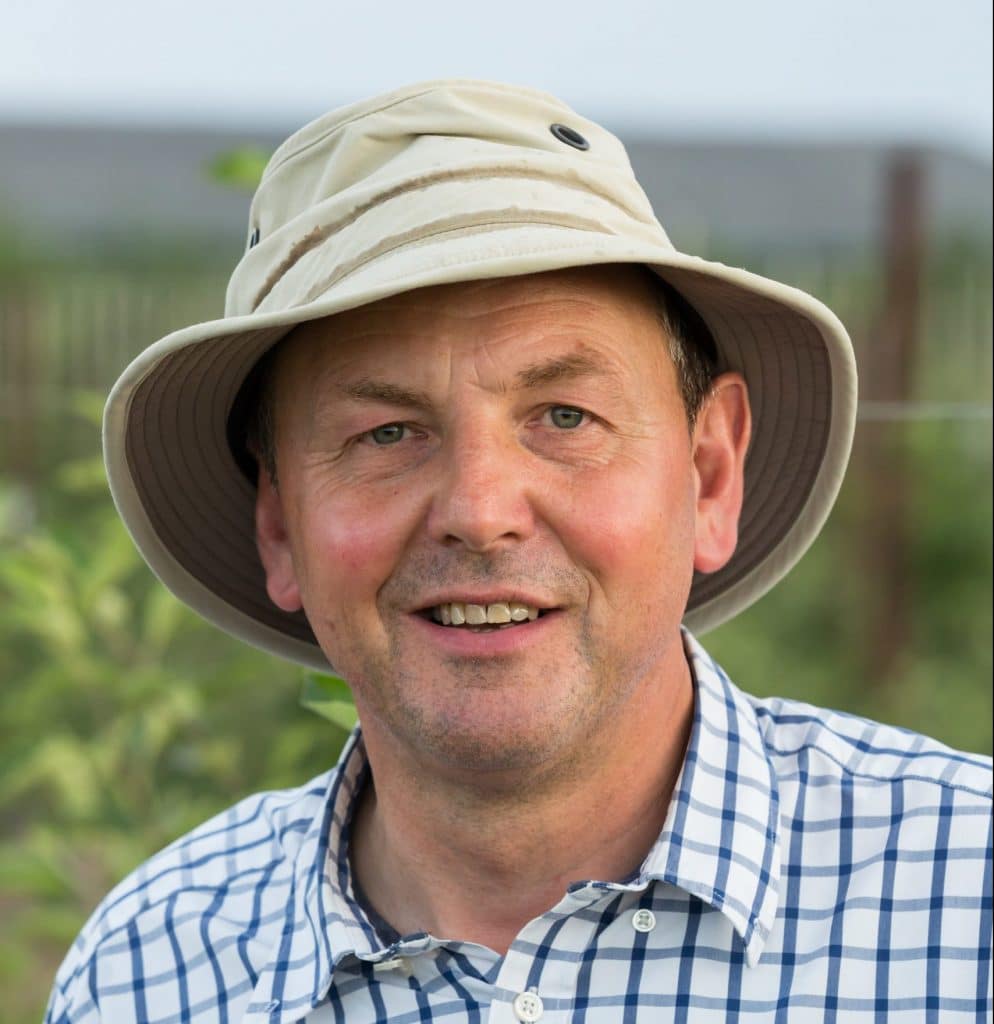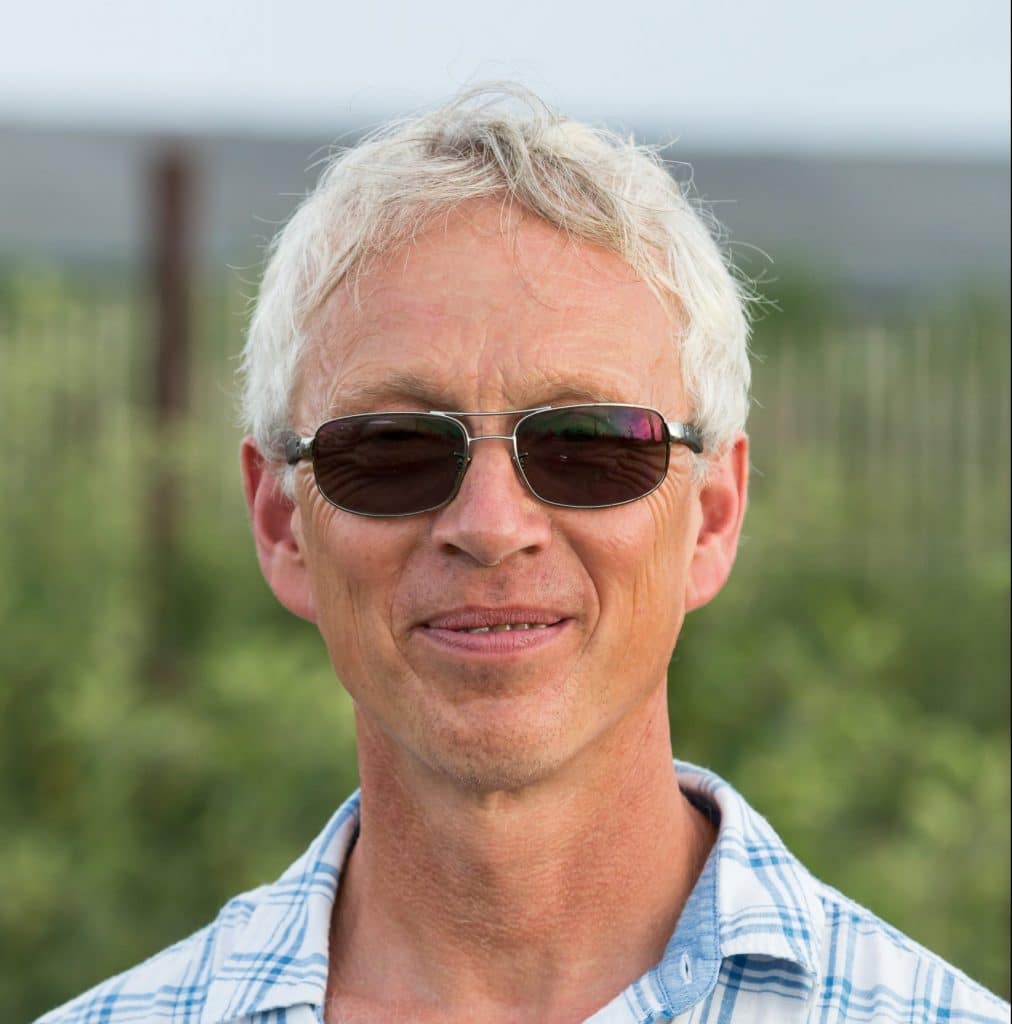Trials delve into the future of orchard design – Fruit Grower – Rob Saunders, Nigel Kitney
From the days of standard trees on 30ftx30ft spacings interplanted with soft-fruit or grazed by sheep, to modern single-row, M9-rootstock, post-and-wire systems, orchard designs have come a long way ...
By historical standards they are productive too, with commercial UK orchards producing up to 80 tonnes/ha in a good year.
But yields may be reaching something of a plateau and, as margins tighten, it may be time to rethink orchard designs so that growers can better withstand the economic, agronomic, technological, and practical challenges of future apple production.
The fruit team at Hutchinsons is tackling this head-on, with a ground-breaking project examining how orchards can be redesigned to simultaneously improve yields and pave the way for robotic technology.
The Hutchinsons Enhanced Light Interception Orchard System (HELIOS) trials build on work by Dr Stuart Tustin in New Zealand, who found that, although single-row spindle orchards are highly productive in historic terms they still only intercept around 60 per cent of sunlight.
Identical HELIOS trials were established at two sites in Kent and Gloucestershire three years ago to assess the long-term performance of several ‘robot-ready’ canopy designs that cost- effectively maximise light interception and yields. Alternative rootstocks and new varieties are also being investigated to judge performance in contrasting UK conditions.
The Kent site is managed by Hutchinsons agronomist Rob Saunders who believes that while the pace of change for orchard designs has slowed, peak orchard productivity has not been reached. However future designs could look very different depending on the outcome of the HELIOS project. “M9 on post-and-wire is productive by historical standards, but they’re not without their problems,” he says.
The rootstock’s vigour means that closely planted trees have a tendency for their crop to migrate up the tree over time, increasing costs, while complex, thick canopies are a challenge for harvesting machinery especially as more automation becomes mainstream. The M9 rootstock also seems to predispose susceptible varieties to canker, Rob Saunders says. “But most importantly 40 per cent of sunlight is not being utilised. As yield is ultimately a function of how much light is captured and converted into sugars that is a real problem.”

Rob Saunders
The HELIOS trials aim to address these issues with future-proof designs that are easy to manage and suitable for automated harvesting. “We’ve planted a range of configurations, generally based around planar canopies with a high density of fruiting stems.”
The solar panel effect
One of the most striking designs is the ‘photovoltaic’ tree configuration, using M9 and M116 Guyot rootstocks, angled backwards on a 50-degree slope, orientated east-west like ground-mounted solar panels.
Theoretically this design will capture twice as much light as a standard north-south orientation, but is challenging to establish and it remains to be seen whether leaves can utilise intense afternoon sunlight in the same way as a photovoltaic (PV) panel. Results from 2020 show reasonable yields in the M9 PV trial, but most striking is the high proportion (65% to 70%) of large fruit (>70mm) produced on both plots, Rob Saunders says.
In terms of outright yield though, the highest output during 2020 was in the ‘V’ configuration of alternate leaning trees based on the M9 rootstock, spaced 40cm apart to form a dense V-shaped planar canopy, inspired by the V-system used in pear orchards.

Nigel Kitney
It is thought that sloping the trees helps to reduce vigour and capture more sunlight. But while the dense planting gives very high yield potential, it is expensive to establish.
A cheaper way of achieving a similar structure is also being trialled, using the more vigorous M26 rootstock. This involves growing four limbs from each tree to create a spindle system with the same density as the M9 system, fellow agronomist and HELIOS west co-ordinator Nigel Kitney explains.
“Unfortunately, because the trees were small, we couldn’t use weed killer in the first year, and in the following winter rabbits also hammered them so it’s taken a couple of seasons to get back into growth. However, it’s really starting to look quite exciting now. We should start getting a crop next season and we hope that in three years they’ll look similar to the M9 V-spindle.”
Low-cost intensive
HELIOS is also trialling lower-cost alternatives to the typical approach of growing M9 rootstocks at high density using expensive trellis work.
One solution could involve the extensive rooting capacity of the M116 rootstock to grow highly productive trees that are largely self-supporting, eliminating the cost of the post-and-wire. “M116 is a really interesting rootstock,” says Rob Saunders. “It’s very resistant to collar rot (Phytophthora cactorum), it has resistance to woolly apple aphid, is strong enough to stand on its own, and scion woodgrafted onto it appears to be less prone to canker. We want to see if it could be the basis for a low-cost intensive orchard with minimal support.”
In the HELIOS trials, plots of trees on M116 are being grown using a multileader ‘laydown’ system as pioneered by Dr Tustin. The main stem is grown vertically to the top of the rabbit guards then angled at 20degrees above horizontal. From that laid stem, four vertical stems 40cm apart are grown on each tree. At a row spacing of 1.8m the system gives 3,700 trees/ha, equivalent to almost 15,000 stems/ha. “We’re hoping to hang 10kg of fruit on each stem so are looking at potential yields of 150 tonnes/ha,” says Rob Saunders.
The planar canopy has very little branching and fruit forms close to each vertical stem, so the system should be easy to manage, he adds. “The light interception and quality that we’ve seen so far is very attractive and the yield potential is phenomenal.” Furthermore analysis of fruit size distribution in 2020 shows a significant proportion within the marketable 60mm to 70mm category. Brix levels were also very encouraging which bodes well for eating and storage quality. “We think that fruits on these trees are slightly later to mature but all the plots were picked on the same day so Brix potential could be even higher.”
Another potential successor to M9 that is being evaluated is Geneva 11 (G11). Nigel Kitney says that the rootstock is particularly interesting for alleviating the impact of apple replant disease in new orchards planted on the site of a previous one. At HELIOS trees on G11 have been planted through a membrane to simulate how they might be grown if herbicides are lost in the future. The roots are trimmed in a system called ‘stringfellowing’. “They were planted just before the heatwave in 2020 but have established remarkably well,” says Nigel.
Elsewhere, he is trialling a centrifugal pruning system as an alternative to planar canopies. This involves growing fruit further from the main trunk, leaving 30cm of bare branch stem to improve light penetration through the mature tree. French trials have shown very good yields and lower pruning and thinning costs so it will be interesting to see if similar results can be achieved, he says.
New varieties
HELIOS is also showcasing some new varieties, one of which is a coded type from Carolus. “It was only planted last spring, but is already cropping nicely,” says Nigel Kitney. “It’s early maturing – we harvested on 11 August this year – crisp, juicy, with slight acidity and aromatics, and keeps well in store, so is very promising for the future.”
New Magnum trees from Carolus are also being trialled, as are Jester trees as alternative pollinators to Malus. Jester’s pollen tubes grow at low temperatures so can be particularly effective in cold springs, he notes.
